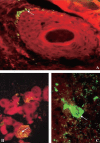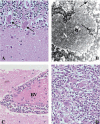Antemortem diagnosis of new york human rabies case and review of u.s. Cases
- PMID: 23675013
- PMCID: PMC3614649
Antemortem diagnosis of new york human rabies case and review of u.s. Cases
Abstract
To help elucidate rabies disease patterns and control issues, a full assessment of a human case of dog-variant rabies was undertaken. In 2000, a 54-year-old man presented to a New York hospital with lower back discomfort four days after arrival from Africa. Rabies was first suspected 8 days after hospitalization based on clinical signs, specimens were collected on the same day, and rabies infection was confirmed the following day (fluorescence antibody testing on nuchal skin biopsy specimen). By the 12(th) day after illness onset, he was unresponsive, and life support was removed on day 15. Subsequently, an African dog variant was confirmed by nucleic acid sequence analysis of rabies viral RNA extracted and amplified from the patient's saliva. Management of human concerns about exposure to the patient kept the number of persons receiving postexposure prophylaxis to 26. With less than half of the U.S. human rabies cases being diagnosed antemortem, this case emphasizes the need to routinely include rabies in the differential diagnosis of any unexplained encephalitis to ensure early confirmation and triage of human contacts to reduce associated healthcare costs.
Keywords: dog diseases; fluorescent antibody technique; inclusion bodies; rabies; reverse transcriptase polymerase chain reaction; virus disease.
Figures



Similar articles
-
[A human rabies case with antemortem diagnosis].Mikrobiyol Bul. 2010 Apr;44(2):303-9. Mikrobiyol Bul. 2010. PMID: 20549967 Turkish.
-
Epidemiology of human rabies in the United States, 1980 to 1996.Ann Intern Med. 1998 Jun 1;128(11):922-30. doi: 10.7326/0003-4819-128-11-199806010-00012. Ann Intern Med. 1998. PMID: 9634432 Review.
-
Human rabies---Virginia, 2009.MMWR Morb Mortal Wkly Rep. 2010 Oct 1;59(38):1236-8. MMWR Morb Mortal Wkly Rep. 2010. PMID: 20881935
-
Imported human rabies in a U.S. Army soldier - New York, 2011.MMWR Morb Mortal Wkly Rep. 2012 May 4;61(17):302-5. MMWR Morb Mortal Wkly Rep. 2012. PMID: 22552206
-
Unique clinical and imaging findings in a first ever documented PCR positive rabies survival patient: A case report.J Clin Virol. 2015 Sep;70:83-88. doi: 10.1016/j.jcv.2015.07.003. Epub 2015 Jul 7. J Clin Virol. 2015. PMID: 26305826 Review.
Cited by
-
Rabies: still a uniformly fatal disease? Historical occurrence, epidemiological trends, and paradigm shifts.Curr Infect Dis Rep. 2012 Aug;14(4):408-22. doi: 10.1007/s11908-012-0268-2. Curr Infect Dis Rep. 2012. PMID: 22699971
-
Diagnostic difficulties in human rabies: A case report and review of the literature.Qatar Med J. 2017 Apr 21;2016(2):15. doi: 10.5339/qmj.2016.15. eCollection 2016. Qatar Med J. 2017. PMID: 28534007 Free PMC article.
-
Molecular characterisation of human rabies in Tanzania and Kenya: a case series report and phylogenetic investigation.Infect Dis Poverty. 2024 Oct 28;13(1):79. doi: 10.1186/s40249-024-01245-w. Infect Dis Poverty. 2024. PMID: 39468631 Free PMC article.
-
Terrestrial rabies and human postexposure prophylaxis, New York, USA.Emerg Infect Dis. 2010 Mar;16(3):527-9. doi: 10.3201/eid1603.090298. Emerg Infect Dis. 2010. PMID: 20202438 Free PMC article.
References
-
- Palmer A, McVey E, McNeill KM, Hand S, et al. Human Rabies-Mississippi, 2005. Morb. Mortal. Wkly. Rep. 2006;55(8):207. - PubMed
-
- Eidson M, Trimarchi CV. In: Conn’s Current Therapy 2006. Rakel RE, Bope ET, editors. Philadelphia: Saunders, Elsevier; 2005. p. 156.
-
- Warrell MJ, Warrell DA. Rabies and other Lyssavirus diseases. The Lancet. 2004;363:959. - PubMed
-
- Trimarchi CV. In: Clinical Virology Manual. 3rd. Spector S, Hodinka R, Young S, editors. Washington DC: ASM Press; 2000. p. 338.
-
- Trimarchi CV, Smith JS. Diagnostic Evaluation. In: Jackson A, Wunner W, editors. Rabies. 1st. San Diego: Academic Press; 2002. p. 307.
Publication types
LinkOut - more resources
Full Text Sources
